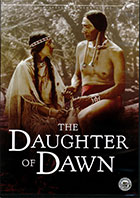
The Daughter of Dawn 2016
Distributed by Milestone Films & Video, PO Box 128, Harrington Park, NJ 07640-0128; 800-603-1104
Directed by Norbert A. Myles
DVD, color and b&w, 87 min.
High School - General Adult
Films, Native Americans
Date Entered: 12/21/2016
Reviewed by Oksana Dykyj, Head, Visual Media Resources, Concordia University, MontrealThe Daughter of Dawn was rediscovered nearly 90 years after it disappeared following a handful of screenings in 1920. The fact that a print used for determining color tinting was discovered and made its way back to the state where it was originally shot is nothing short of a miracle. The Library of Congress has rightly selected it to be added to the National Film Registry and it was beautifully restored by Milestone Film and Video in 2015.
As usual, Milestone provides special features rich with information for contextualizing the film. We are told that films made between 1910 and 1920 have only a 10% survival rate according to the Library of Congress and so to have The Daughter of Dawn materialize after a long absence is especially important in the documentation of Native American tribes. The film was shot in the Wichita Mountains of Oklahoma where buffalo hunting was part of the culture. To see the hunt documented in this film provides viewers with a unique historical opportunity. The director Norbert Miles, selected an all Native American cast consisting of more than 300 actors from both the Kiawa and Comanche tribes. They brought with them their ceremonial clothing, their teepees, horses and traditions. The dancing and rituals are authentic to the period.
The narrative is a typical quadrangle love story. Red Wing, a young woman is desperately in love with a schemer, Black Wolf, who falls for the Daughter of Dawn, and she in turn is in love with White Eagle who reciprocates her love. There are tests of courage and abductions, with, finally, love triumphing for the young couple in love. The imagery is breathtaking with some shots of the landscape evocative of the look of later John Ford directed films. The details are also worth noting, as the costumes, adornments and teepees show the richness of the Kiawa and Comanche cultures.
Finally, the music commissioned to accompany the film blends in with the narrative and visuals to create a beautiful and authentic love story. The original music was written by David Yeagley, a Comanche, and performed by the Oklahoma City University Symphony Orchestra. This film is highly recommended for areas collecting in film studies, American history, Native American studies and for anyone who enjoys the pleasure of watching a really good silent film.